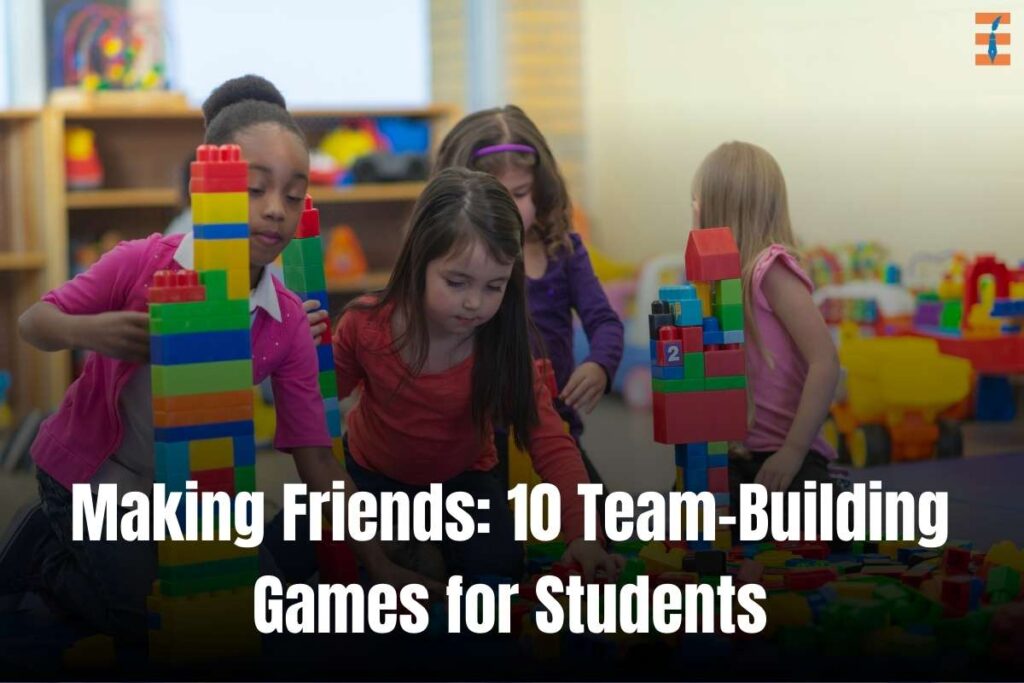Team-building games for students designed to foster collaboration and positivity in the classroom are provided. Jackie Gerstein, a Teach Thought PD provider, created this resource. Gerstein’s blog, User Generated Education, is a treasure trove of useful information on topics like Maker Education and Growth Mindset.
Her 26 years of teaching experience in elementary, secondary, and tertiary settings mean that her tried-and-true team-building activities are used by educators throughout the country. Three of the games are shown graphically up above, while the other seven are listed in text down below.
Here are 10 different Team-building games for students;
1. Virtual Bingo for Kids
Young people may need to isolate themselves for a variety of reasons, including social isolation at school or physical isolation due to illness. For whatever reason, youngsters in faraway locations may benefit from virtual Team-building games for students.
Playing a game of Virtual Bingo from afar is one of the greatest options for children. This activity involves a leader or instructor providing each student with their own personal Bingo card that is pre-filled with questions and statements that were brought up during a virtual class.
When children become aware of or finish one of these activities, they cross it off on the board. Playing bingo online is a fun and novel method to keep children engaged.
There is a Bingo game generator available online if you need additional icebreaker game ideas.
2. Human Knot
The concept of the “human knot” is well known to adults. Playing this Team-building games for students during office hours is frequent. One of the best team building games that is also great for kids is the Human Knot. The need of open dialogue and mutual support among teammates is emphasized. Kids attempting to free themselves from the human knot should also provide some amusement.

The rules of the game are as follows:
- Get youngsters to volunteer in groups of five to eight, or make up your own.
- Encourage the kids to sit in a circle, touching shoulders and legs.
- Have everyone lay their hands in the center. Then, have the kids take turns gently grabbing the wrists of their other players.
- As soon as the knot is formed, have the children unwind themselves carefully and politely without letting go of each other’s hands.
- Strategic planning and coordination are going to be essential for this procedure. A youngster may release a wrist grip temporarily to detangle, but they should re-grab the same wrist as soon as possible.
- Make this game more difficult by having players work together without using words.
- The human knot instruction manual is provided below.
3. Protect the Castle
Children are likely to like any game in which they may toss balls at one another. Because it encourages physical activity and the development of skills and concepts that are useful in everyday life, Protect the Castle is a top choice among Team-building games for students. A gym or large open area like a park is ideal for this activity.
Establishing the Castle Defense System:
- Construct a little circle using the cones. The number of people taking part will determine the diameter of the circle.
- Four or five players should be in the center of the circle, with the other players (no more than ten or twelve) spread out around the perimeter.
- The players on the outside of the circle hurl soft, squishy balls to try to knock down all the cones.
- Those in the center position work to defend the castle by blocking and deflecting throws.
When all the cones have been knocked down, the teams may trade places and play again. Those attempting to storm the castle must coordinate their efforts to find a way inside. Meanwhile, if the children guarding the castle work together, they will have a better chance of preventing any damage.
4. Balloon Juggle-and-Sort
Put the participants to the test by having them maintain the altitude of many inflated balloons each. This helps get everyone up and working together.

When they’ve mastered the basics, ramp up the difficulty by increasing the number of balloons or imposing new rules (e.g. no hands to keep balloons up.)
Then have them continue juggling, but this time by color (works best with large groups.)
5. Catch Me If You Can
Each half of the group is split in half and instructed to form two parallel lines, with their backs to each other.
Teams have about a minute to study the opposite team, paying close attention to each member and noting any differences or similarities.
Both lines swivel around to face away from the hub. Each team gets one minute to make as many cosmetic adjustments as the facilitator deems necessary (i.e., change a watch to a different wrist, unbutton a button, etc.) The alterations need to be subtle but obvious.
Players face each other once again, this time to see whether there have been any visible changes. Winner is the group that makes the most discoveries.
6. Are you more like…?
Invite everyone to stand in the center of the room, and then have them shift to one side to show their support (they must pick one).
It’s either a book or a song.
- Added Apple Music or Spotify?
- What’s your spending/savings ratio like?
- A cheetah or a bear, perhaps?
- similar to now or the future?
- Feeling-driven or reason-driven?
It’s more like to a celestial body.
7. Flip the Sheet
One member of the group stands on top of an open bed sheet while the rest of the group must figure out how to get to the other side without anybody stepping off.
How many people are in the gathering will determine how big a sheet you need. Tarps may be more practical for groups of people.
8. All Aboard
Instruct everyone to cram into a tiny space that you’ve marked off with a circle of rope, a tarp, a blanket, or whatever else that comes to mind.
Outside of the marked area, no part of the body may make contact with the soil.

Reduce the playing space (by moving the platforms, shortening the circle, or folding the tarp) and re-test the group after they’ve mastered the first obstacle.
Can they go any farther as a group?
9. How are we the same?
Participants are instructed to choose a partner and list four things they have in common.
Then, the four individuals in each pair will need to exchange information and come up with a common ground.
The remainder of the group then benefits from these contributions.
10. Line up!
Inform the group that you will be naming a category, and that they must ‘line up’ in order that corresponds to the category.
Everyone gets in line and adjusts their position to find their spot.
No one on the squad can do anything except put and move oneself.
Category Examples:
- What Is Your Due Date? (month and day)
- Please include your middle names in alphabetical order.
- Where you were born is shown in alphabetical order.
- Names should be listed in alphabetical order by the first name of either parent.
Conclusion
Making new friends is a crucial activity for every student as it can ease up the transfer of knowledge and develop new learning techniques. These team-building games for students can strengthen relationships between them and make their classes more fun. You should try these Team-building games for students and see how the environment within the classroom changes. All the best with it!
Also read: 10 Team-Building Games That Promote Critical Thinking










